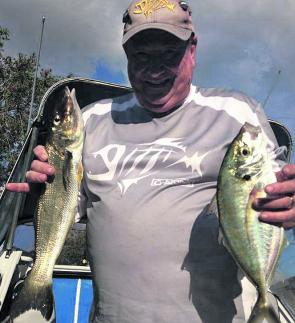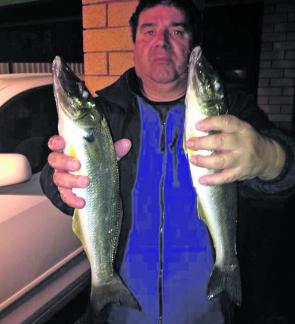Breaming in Botany Bay, unlike other areas, is a year-round proposition. For that reason it must be the most consistent spot on the NSW coast. However, many anglers miss out because they aren’t fishing correctly.
While good fish are taken from the shore, 90% of the bream caught in the bay and lower reaches of the Georges River are taken from boats at anchor. The right gear set-up is essential. You need a flexible tip rod between 2.1m and 2.25m in length (I like the Wilson Live Fibre series), a Baitrunner reel capable of holding at least 150m of 4kg line. The movement of the tide will determine the weight of lead to be used, so a range of sinkers is needed. I recommend an assortment of ball sinkers up to 28g.
Use a size 6 black crane swivel to offset twisting. Hooks will vary, but if you’re using worms, prawns or pink nipper baits I recommend the no. 2 Gamakatsu Baitkeeper. This hook fits those three baits perfectly, and it’s also ideal for catching other species such as whiting and trevally.
Rigging is simple but effective. Use a trace from the swivel the full length of the rod (around 1.8m). This trace allows the bait to move around and will help you get more good catches. In addition, a small lumo beat is very effective above the swivel as it minimises any noise the sinker may make in hitting the swivel.
After baiting up, cast a good 25m out and then relax the Baitrunner to its minimum drag, thus allowing the line to have a smooth runoff. This will allow the fish to take the bait well down without feeling any resistance. I like to fish with two rods and let the fish hook themselves.
Once a fish has struck and the line is peeling off, give the fish plenty of time to swallow the bait. Simply lift the rod out of the holder, raise the tip and feel the weight of the fish. Because you’re using a Baitrunner reel your drag is pre-set and this makes for easier landing. When you’re using this technique you’ll hook more fish and have the bait well down, keeping losses to a minimum.
If you’re fishing near oyster leases, bridge pylons or heavy structure you’ll need heavier tackle with lines up to 6kg. You have to stop the fish in their tracks before they have a chance to cut you off.
I like fishing with a size 00 sinker directly behind the hook and fish one hour either side of the high tide. The slower tidal movement allows the rig to present the bait more naturally and fool the fish. You may lose a few fish this way, but the overall result will make up for these losses.
I don’t drift much for bream but when the fish are scarce it may pay to catch a fish or two then anchor, then move 100m or so and repeat the process.
Always ensure you have a landing net and correctly weighted anchor, plus plenty of rope and at least 2m of galvanised chain so it holds firm in windy conditions.
When it comes to berley for bream, I like to use boiled wheat, flour, bran and fish oil. Mix it all together in a plastic garbage container and drop it over the side of the boat in tight handballs. This will reach the bottom very quickly and bring fish to the area.
The weather over the past month has been very ordinary, restricting activities in the bay. Only the more dedicated anglers have been braving the conditions. They have been rewarded with good catches of trevally, with blurters up to 45cm, but mainly around 30-35cm. They have been coming from Molineaux Point, Trevally Alley and the Kurnell oil wharf.
Flathead catches have been fewer but the size of the fish has made up for this, with lizards up to 60cm. The airport runways drift is the most popular haunt and it’s not too far from the boat ramp.
Luderick have been taken from Bare Island, Sutherland Point and Muddy Creek in the Cooks River, but they’ve been running a bit hot-and-cold lately.
The best run of whiting I’ve seen for many years has been on the cockle beds from Kyle Bay to Caravan Head in the Georges River, with thumper fish to 48cm taken on live blood worms one hour either side of low tide. I have bagged out on these excellent eating fish a few times over the past month in this area.
Luderick catches have varied, but the usual haunts of Blackbutt, Mickey’s Point, Bonnet Bay, Captain Cook and Tom Uglys bridges have proved the most consistent possies. The close inshore reefs from Cape Banks to Long Bay in the north and Kurnell to the boat harbour in the south have provided fair catches of pan-size reds, morwong and leatherjackets, while the 40m mark of the golf tee in the middle of the water tank drift at Kurnell has yielded good sand flathead for anglers using pilchard baits.
October will see schools of bream replace the whiting on the mussel and cockle beds in the Georges River as the former slowly migrates towards the lower areas of the system. They will also congregate in locations such as Watts Reef, the weed corridors between Bonna and Towra Point and the scattered reefs in front of St George Hospital. You’ll find live nippers and the incoming tide a deadly combination.
School mulloway will show up during the full moon period, with the deep hole between the airport runways, the dropover in front of the Novotel at Brighton le Sands. The artificial reef in Astrobalis Cove and Apt Cook and Tom Uglys bridges are popular haunts.
Flathead will be found on the ebbing tide from the bell buoy out from Kurnell to halfway out on the southern shore between the heads. The drift from the refinery wharf to Quibray Bay, and Yarra Bay to la Perouse will also produce good catches.
Tailor will be found at the hot water outlet at night on top of the high tide and the small break wall adjacent to the boat ramp on Foreshore Drive is the sneaky spot to fish at night for snapper and trevally.
Reads: 3152
A good haul of bream and whiting.

The author has been fishing Woronora River a fair bit lately. These are two of his best from a catch of 16 fish a few weeks ago.

Some nice big whiting are being caught around Como at the moment.

Bream can be caught all year in Sydney. Check out the lumpy back on the middle fish.

Ross caught these nice whiting with the author down at the Woronora River.




